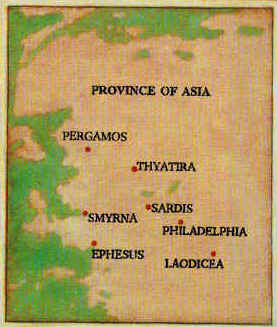Revelation: Seven Letters to Seven Churches
 Revelation’s seven letters to seven congregations in the Roman province of Asia provide us with a glimpse into the spiritual condition of the apostolic and post-apostolic church in a major crossroads area of the Roman world. It has generally been thought that Revelation was written around A.D. 100, though some scholars believe the book may have been written much earlier, in the mid-60s of the first century A.D.
Revelation’s seven letters to seven congregations in the Roman province of Asia provide us with a glimpse into the spiritual condition of the apostolic and post-apostolic church in a major crossroads area of the Roman world. It has generally been thought that Revelation was written around A.D. 100, though some scholars believe the book may have been written much earlier, in the mid-60s of the first century A.D.
In either case, the problems of faith found in some of the congregations should give us great pause. Since the church of the apostles and succeeding generation was beset by the spiritual crises described in Revelation 2-3, then we must also ask ourselves as Christians about our own faithfulness to the Savior. On the other hand, some of the congregations exhibited characteristics greatly praised by Jesus. This is a cause for much encouragement.
Thus, if we take to heart both the admonitions about the spiritual weaknesses and praise for the strengths of these congregations we can be both sobered and inspired. Finally, by meditating on the assurance of the promise of salvation given to each church by our Savior, we can receive comfort, joy and peace in our lives.
Message to the “seven angels” of the churches
The last verse of the first chapter provides an introduction to the messages of the seven churches, which were located in the Roman province of Asia (today, southwestern Turkey) (1:20). Chapters 2 and 3 of Revelation contain seven letters to these church congregations. These were not the only churches in the area, but these seven letters give us a picture of the spiritual condition of the church in the Roman province of Asia at the time the book was written.
The fact that Revelation is written to real congregations of Christians places the book squarely in the real world of human beings. The letters were written to seven churches that existed at a particular time in history. Real people with strengths and problems like our own made up their congregations. These are letters, not prophecies of the future.
Each of the seven letters begins with Jesus speaking to members of his church. One of several attributes of his majesty, given in the first chapter, is repeated and placed at the heading of each letter. The descriptive phrase chosen from the vision is appropriate to each specific church. When such phrases run out, other pertinent statements regarding Christ’s attributes are used.
The letters respectively commend the churches for their strong spiritual works and reprimand them about their specific spiritual problems. Forceful warnings to repent are given to those who are spiritually weak, along with encouragement to persevere in the faith. The letters also contain promises to those who overcome – promises of great assurance about their eternal life in the kingdom of God. These promises are given in symbolic terms.
 Each letter concludes with the same statement: “He who has an ear, let him hear what the Spirit says to the churches…” (2:7, 11, 17, 29; 3:6, 13, 22). The word here is “churches,” in the plural. This implies that the words written to each congregation are meant to apply to all seven churches. This means that the seven individual church messages were meant for all the congregations in Asia of John’s day – and, by extension, for the entire church of the time.
Each letter concludes with the same statement: “He who has an ear, let him hear what the Spirit says to the churches…” (2:7, 11, 17, 29; 3:6, 13, 22). The word here is “churches,” in the plural. This implies that the words written to each congregation are meant to apply to all seven churches. This means that the seven individual church messages were meant for all the congregations in Asia of John’s day – and, by extension, for the entire church of the time.
We could also infer that the spiritual condition of these seven congregations is characteristic of every group of Christians during the last 1900 years. Certainly, God’s people in all ages should be concerned about the spiritual problems described in each of the letters and take assurance in the promise that the overcomers will inherit all things with their Savior, Jesus Christ.
Author: Paul Kroll

